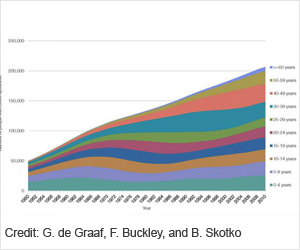The new detailed estimation of Down syndrome may be useful for policymakers to better appraise the impact of proposed legislation for this population.

TOP INSIGHT
The number of Hispanics with Down syndrome has been growing incrementally, while numbers among non-Hispanic whites have been declining.
"With these new detailed estimates, we hope that policymakers can better appraise the impact of proposed legislation for this population, which has to evolve racial and ethnic compositions, and nonprofit groups can better assess how representative their members are of the population at large. We also have established a crucial baseline to establish the effects, if any, of noninvasive prenatal testing for Down syndrome that has become available across the country," he says.
Skotko and his co-authors - lead author Gert de Graaf, PhD, Dutch Down Syndrome Foundation, and Frank Buckley, Down Syndrome Education International/USA - have conducted several studies estimating numbers of individuals with Down syndrome nationwide or in areas like the state of Massachusetts and examining the effects of factors such as prenatal testing on total numbers. Other groups have estimated the prevalence of Down syndrome - numbers of individuals with Down syndrome per 10,000 population - at specific points in time, but this is the first to estimate how numbers have changed over a 60-year period.
The research team based their estimates on what they believe to be a larger and more accurate set of databases than previous studies have used - covering factors such as the numbers of children born with Down syndrome, how those numbers have been affected by changes in the overall population and by the availability of prenatal testing and elective termination, and how many individuals with the condition have survived to adulthood. The total number they arrived at for 2010 was 206,366 individuals with Down syndrome in the U.S., compared with almost 50,000 in 1950, including both those born in the U.S. and those who moved to the U.S. after being born in other countries. The population prevalence for 2010 was 6.7 per 10,000 for the overall population.
Broken down by ethnic and racial groups, the total 2010 estimates were 138,019 non-Hispanic whites, 27,151 non-Hispanic blacks, 32,933 Hispanics, 6,747 Asians/Pacific Islanders, and 1,527 Native Americans/Alaskans. For all ethnic and racial groups, numbers of individuals with Down syndrome were greater in younger age groups, but the growth over the years in the numbers of older individuals with Down syndrome reflects how the condition has changed from what was almost exclusively a childhood disability in the 1950s to one impacting a significant number of adults and older Americans.
An assistant professor of Pediatrics at Harvard Medical School, Skotko adds that their data on the ethnic diversity of the Down syndrome population will be valuable to organizations providing services to individuals with Down syndrome and their families. "Nonprofit support groups can now ask, for example, 'How many non-Hispanic blacks with Down syndrome are in our membership, and are the numbers representative of the local and national populations?' The number of Hispanics with Down syndrome has been growing incrementally, reflecting the growth of that population, while numbers among non-Hispanic whites have been slowing. Now we can begin to ask whether our resources, health care, and support systems are evolving to meet the needs of the changing population."
Source-Eurekalert
 MEDINDIA
MEDINDIA




 Email
Email





